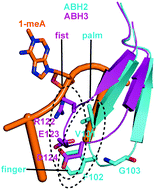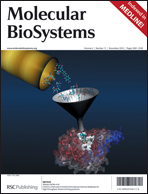Mechanistic insight into the recognition of single-stranded and double-stranded DNA substrates by ABH2 and ABH3†
Abstract
The human ABH2 and ABH3 proteins are functionally complementary in the oxidative demethylation of N1-methyl adenine (1-meA) and N3-methyl cytosine (3-meC) nucleotide bases. ABH3 displays higher activities with single-stranded DNA (ssDNA) in vitro, whereas ABH2 acts as the primary housekeeping enzyme in mammals for effectively repairing endogenously formed alkylated lesions in double-stranded DNA (dsDNA). Structurally, their overall protein folding is quite similar, but the most significant differences occur in the nucleotide recognition lid and the β-hairpin motif. We present here a site-directed mutational analysis and motif-swapping study to gain mechanistic insight into DNA substrate selection by ABH2 and ABH3. A V101A-F102A double mutant notably reduced ABH2 activity in dsDNA, indicating that this hydrophobic region appears to be important for damage searching and repair. The phenylalanine finger F102 is found to be crucial for ssDNA selection and repair as well; however, V101 shows reduced demethylating activity for only ssDNA and not dsDNA. The ABH2 R110A mutant completely loses the methyl base repair activity, suggesting that R110 is likely to be involved in the base flipping process. E175 and F124 contribute to nucleotide base specific selection and stabilization in the active site for repair. Additionally, swapping the RED residues in ABH3 to equivalent VFG residues in ABH2 endows ABH3 with activity in dsDNA repair as efficient as wild-type ABH2. Surprisingly, by changing just a few residues, the ABH3 protein can have very different selectivity towards ssDNA or dsDNA. This result indicates that the RED motif most likely prevents ABH3 binding and repair of dsDNA. Consistently, swapped ABH3 cross-links with dsDNA very well, confirming the determining roles of these residues in the initial DNA strand recognition. Overall, this work has provided a detailed understanding of the structural features of the ssDNA and dsDNA preferences of ABH2 and ABH3.


 Please wait while we load your content...
Please wait while we load your content...